L05 Non‐Mendelian Inheritance
Maternal Effect 母体效应
A maternal effect is a situation where the phenotype of an organism is determined not only by the environment it experiences and its genotype, but also by the environment and genotype of its mother.
- Involve genes in the nucleus
- Genotype of offspring does not directly govern phenotype as predicted by Mendel
Maternal effect refers to an inheritance pattern for certain nuclear genes in which the genotype(基因型) of the mother directly determines the phenotype(表型) of her offspring
Surprisingly, the genotypes of the father and offspring themselves do not affect the phenotype of the offspring
This phenomenon is due to the accumulation of gene products that the mother provides to her developing eggs
1. Example of Snail coiling inheritance pattern
- Right‐handed (dextral) ,The dextral orientation is more common and dominant
- Left‐handed (sinistral)
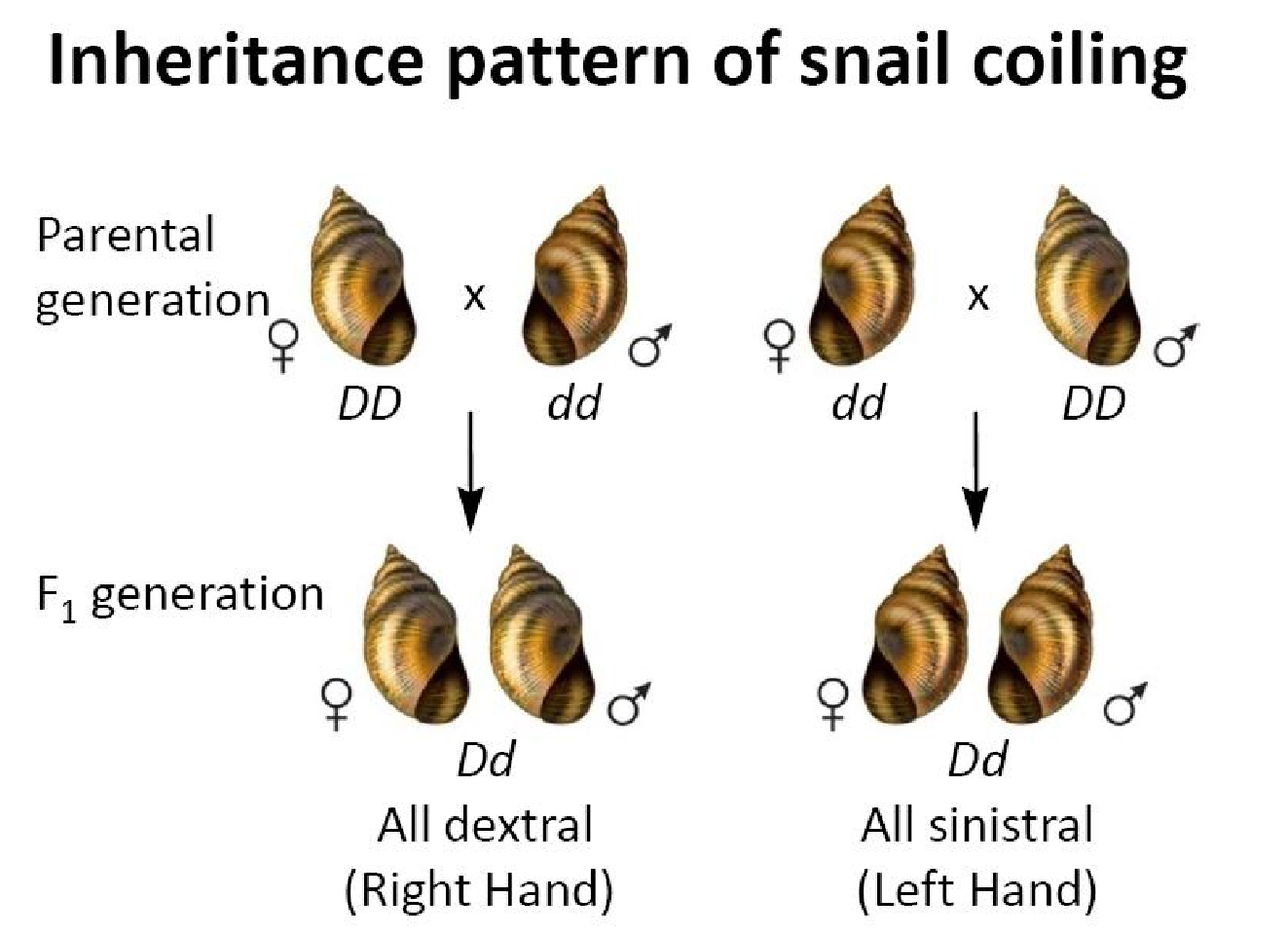
Maternal effect refers to an inheritance pattern for certain nuclear genes in which the genotype of the mother directly determines the phenotype of her offspring
并不是亲本雌性的表现型决定了子代的形状,本质上仍然是母本的基因型决定子代性状。
This phenomenon is due to the accumulation of gene products that the mother provides to her developing eggs
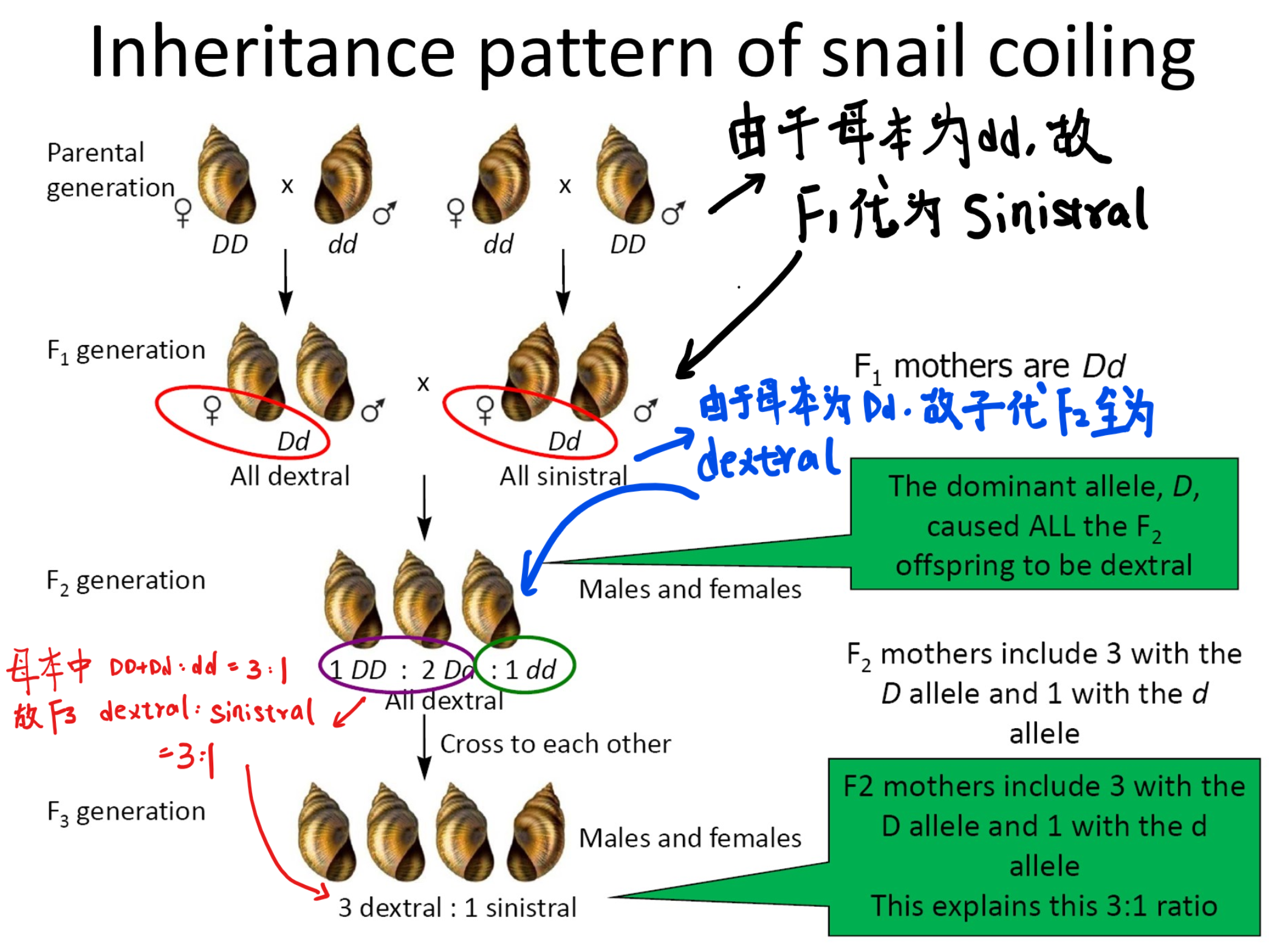
2. Mechanism of maternal effect in snail coiling
The gene products are a reflection of the genotype of the mother
They are transported to the cytoplasm of the oocyte where they persist for a significant time after the egg has been fertilized
Thus influencing the early developmental stages of the embryo
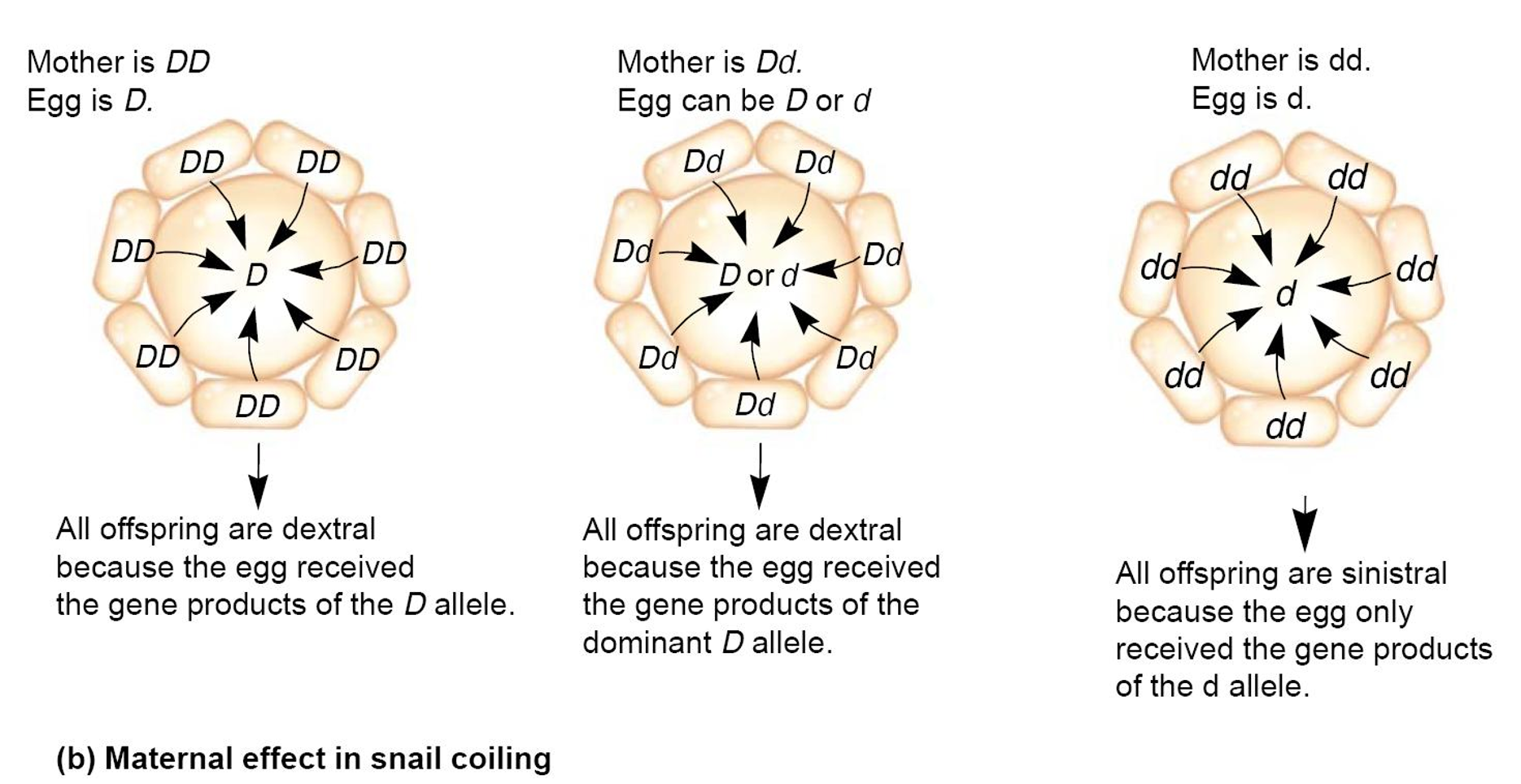
Epigenetic(表观遗传学) inheritance
Epigenetic inheritance refers to a pattern in which a modification occurs to a nuclear gene or chromosome that alters gene expression
However, the expression is not permanently changed over the course of many generations. That is because the DNA sequence does not change
Epigenetic changes are caused by DNA and chromosomal modifications
These can occur during oogenesis, spermatogenesis or early embryonic development
表征遗传现象包括DNA、RNA干扰、组蛋白修饰等。与经典遗传学以研究基因序列影响生物学功能为核心相比,表征遗传学主要研究这些“表征遗传现象”建立和维持的机制。其研究内容主要包括两类,一类为基因选择性转录表达的调控,有DNA甲基化、基因印记、组蛋白共价修饰和染色质重塑;另一类为基因转录后的调控,包括基因组中非编码RNA、微小RNA、反义RNA、内含子及核糖开关等。
1. DNA Methylation
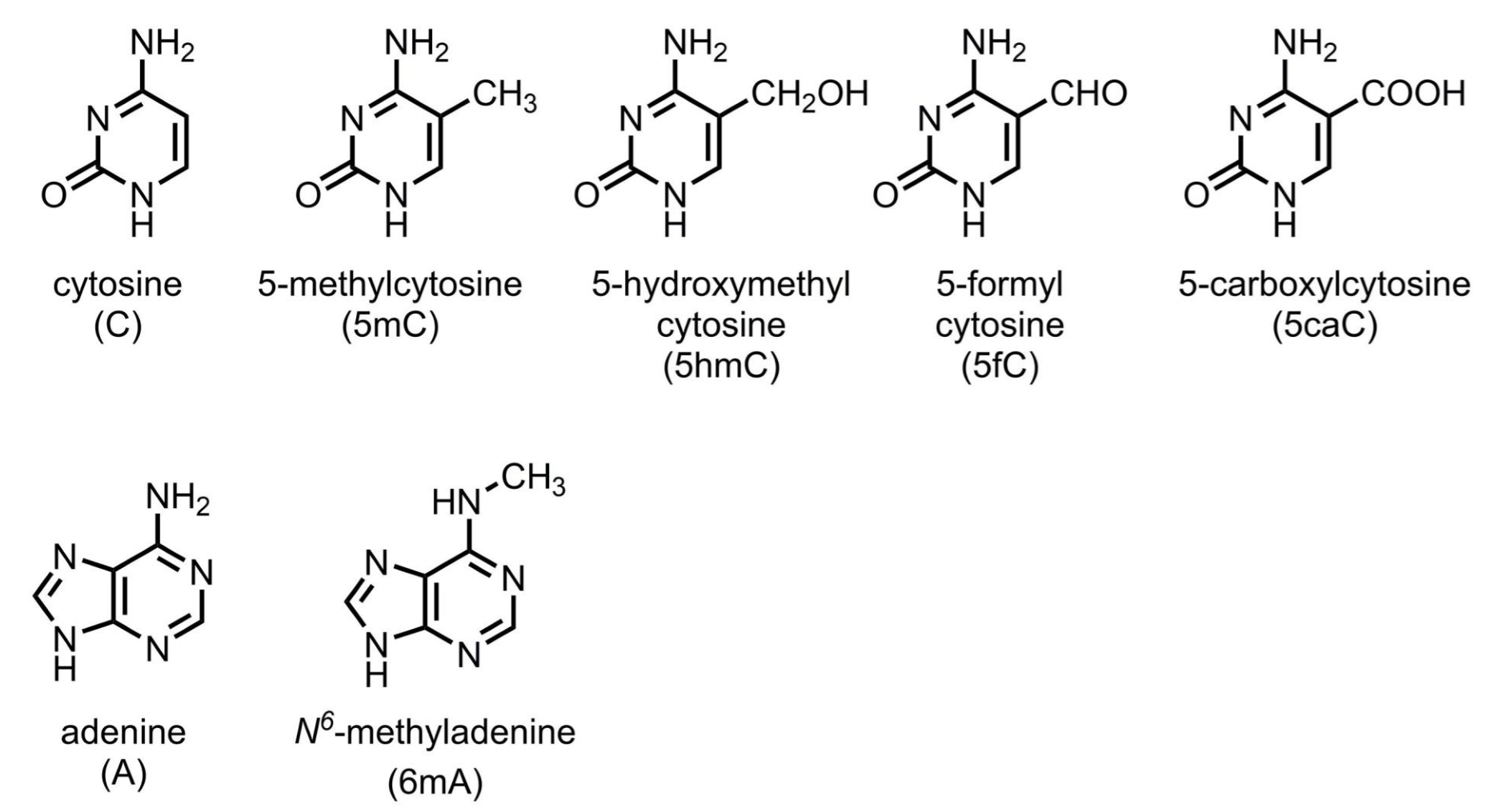
核苷酸可以通过一定的修饰,影响基因的表达,而修饰过的核苷酸同样可以正常配对。
Cytosine methylation occurs predominantly at CpG dinucleotides which are palindromic(胞嘧啶甲基化主要发生在回文的CpG二核苷酸上)
基因组某些区域的甲基化较多,甲基化较高的区域通过不完全清楚的机制使得转录的活力减小。甲基化的胞核嘧啶也可以从父母一方的生殖细胞保留在受精卵中,标记染色体遗传自双亲(遗传印记)。
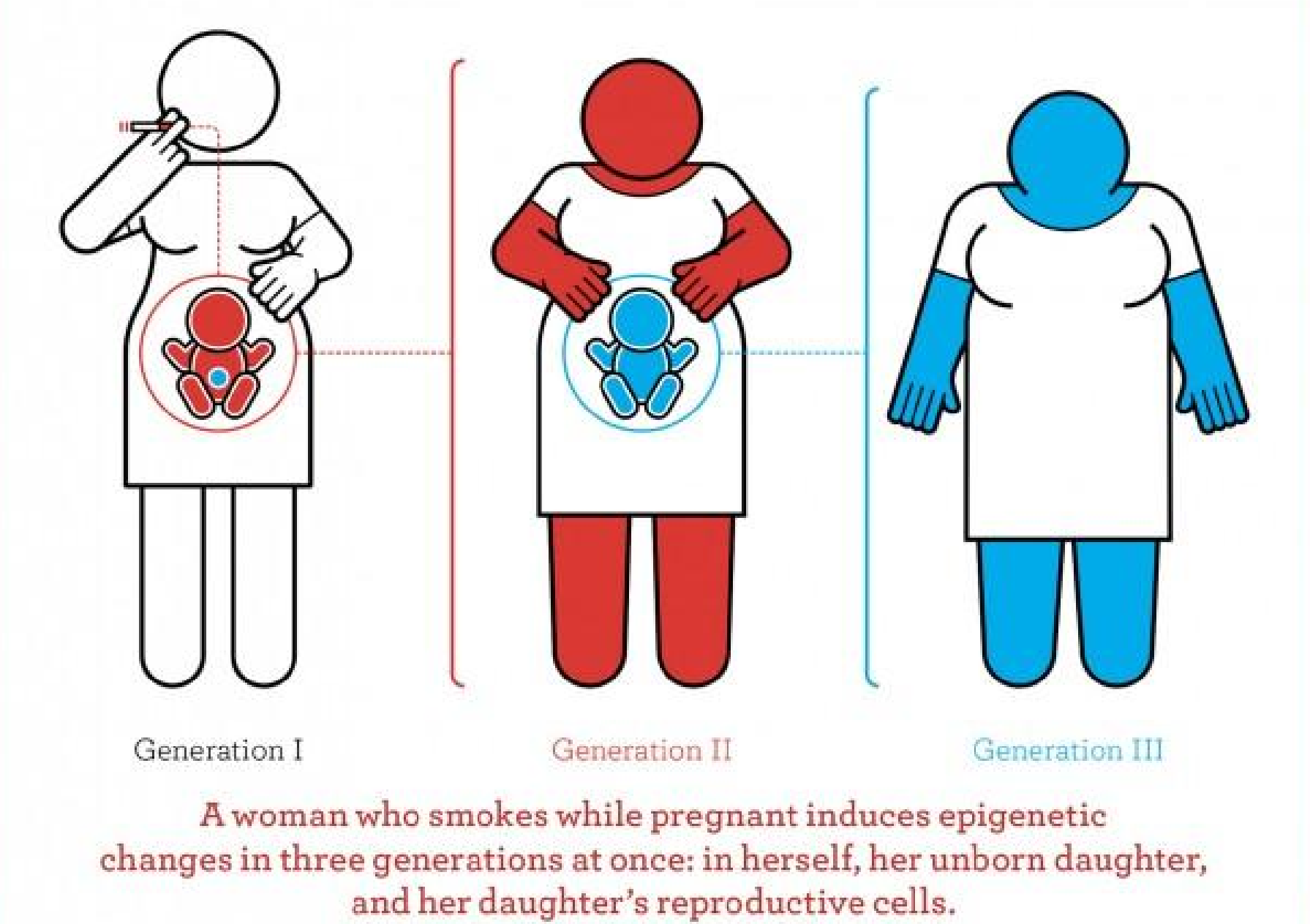
2. Dosage compensation (计量补偿(效应))
Dosage Compensation is the equalization of gene expression between the males and females of a species. Because sex chromosomes contain different numbers of genes, different species of organisms have developed different mechanisms to cope with this inequality.
Discovery
In 1949, Murray Barr and Ewart Bertram identified a highly condensed structure in the interphase nuclei of somatic cells in female cats but not in male cats.
This structure became known as the Barr body(巴尔小体)——具有两个以上X染色体(或Z染色体)的细胞中,其中一条X或Z染色体去活化而成的紧密结构,如此会使该染色体上的基因不至于过度表现
In 1960, Susumu Ohno proposed that the Barr body is a highly condensed X chromosome.
In 1961, Mary Lyon proposed that dosage compensation in mammals occurs by the inactivation of a single X chromosome in females.
Offset
The purpose of dosage compensation is to offset(补偿) differences in the number of active sex chromosomes
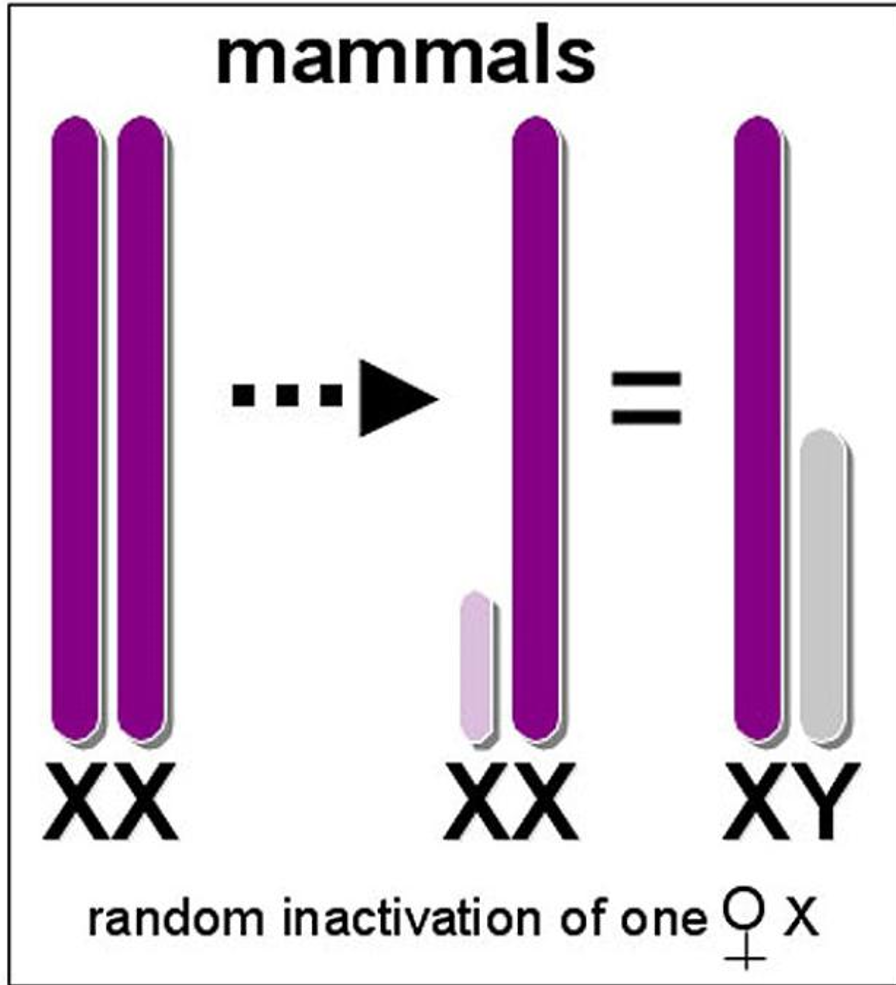
X‐inactivation in Calico cats

三色猫的斑驳毛色是巴尔氏体的表现,“黑色皮毛”与“橙色皮毛”的等位基因位于不同的X染色体上。由于去活化的对象是随机选择,因此不同部位,会依保留活性之染色体的不同,而有不同的毛色。
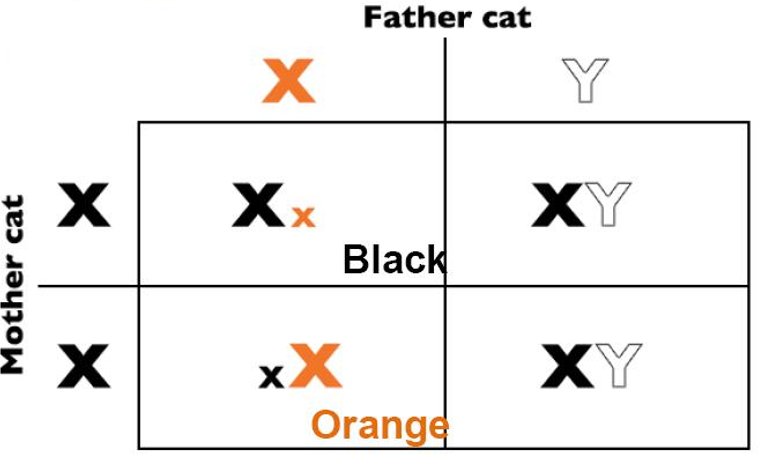
Inactivation of a single X chromosome in early embryo :
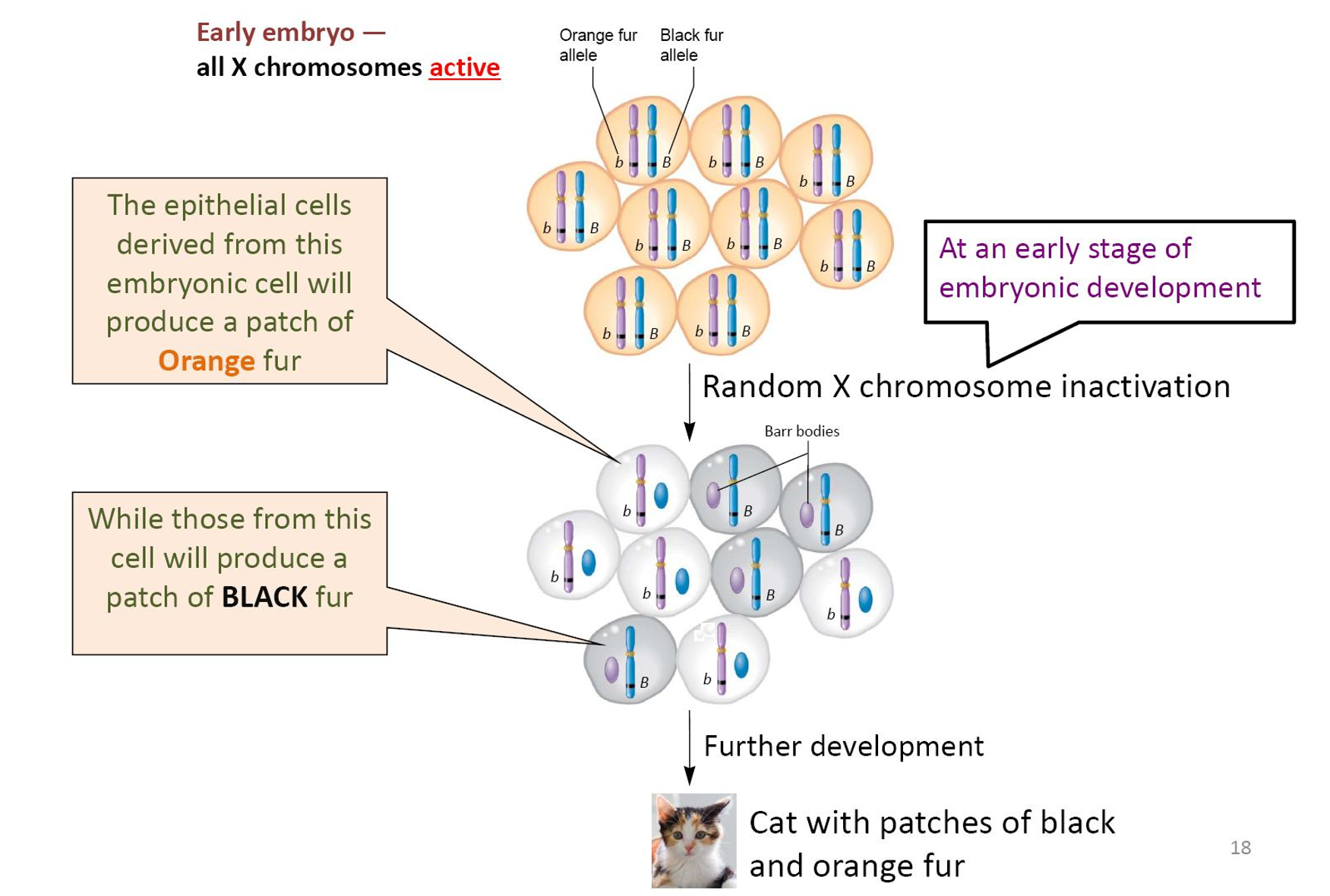
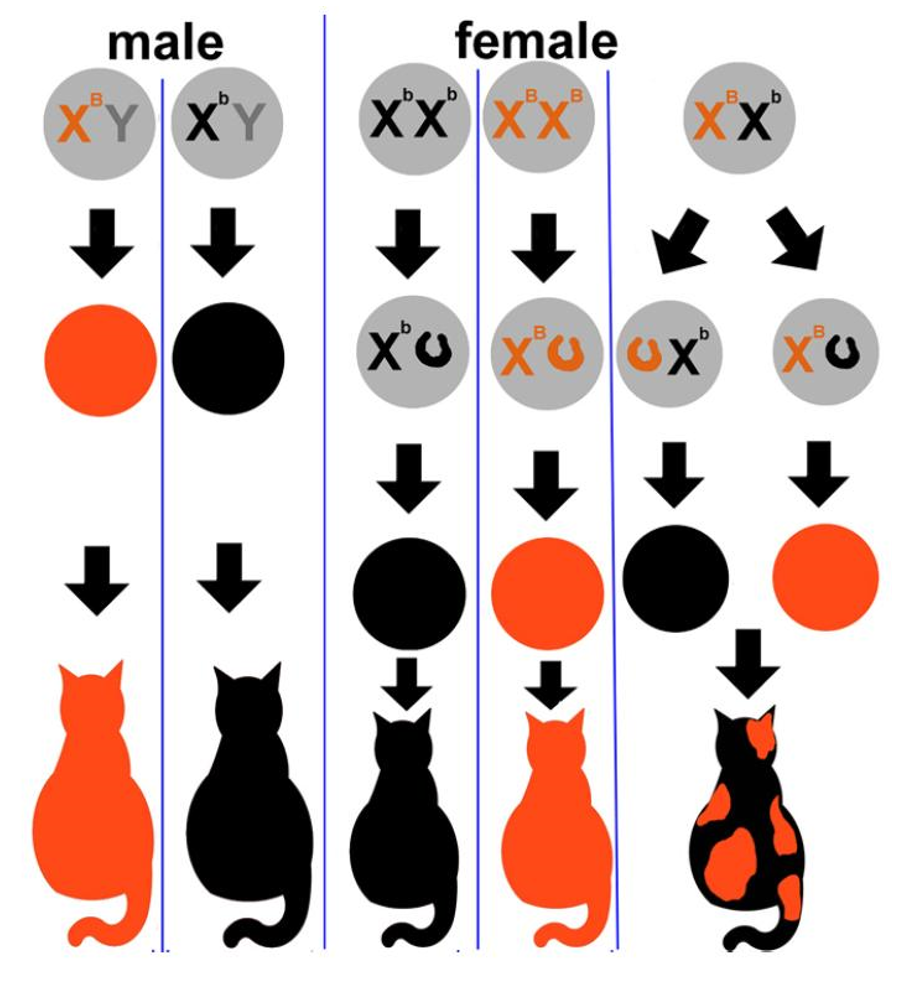
Potential mechanism of X chromosome inactivation
失活的X染色体(Xi)由其上的某个点开始往两头产生皱缩,直到染色体的末端,这个开始产生皱缩的点被称为“X失活中心”(英语:X inactivation center, Xic),X失活中心共含有12个基因,其中7个编码蛋白质,另外5个则编码Xist(X-inactive specific transcript,意为失活X染色体特定转录)和Tsix(Xist的反义序列)等长链非编码RNA
Xist是执行X染色体去活化的基因,其转录出的RNA会把Xi包围,介导修饰染色体的酵素与其结合,以进行组蛋白甲基化(例如由多梳家族蛋白(PRC2)造成的H3K27me3、H3K9me3)、组蛋白泛素化、CpG位点的DNA甲基化等修饰,达到基因沉默的效果,最终使Xi皱缩成巴尔氏体,其上多数基因都无法表现
Tsix基因是Xist的反义序列,是Xist的负向调节因子(a sequence of DNA that represses the expression of certain genes),可与Xist结合后,使其被Dicer(人体内由DICER1基因编码,是一种在RNA干扰中扮演着重要角色的RNA酶,属于III型RNA酶(RNase III))降解。
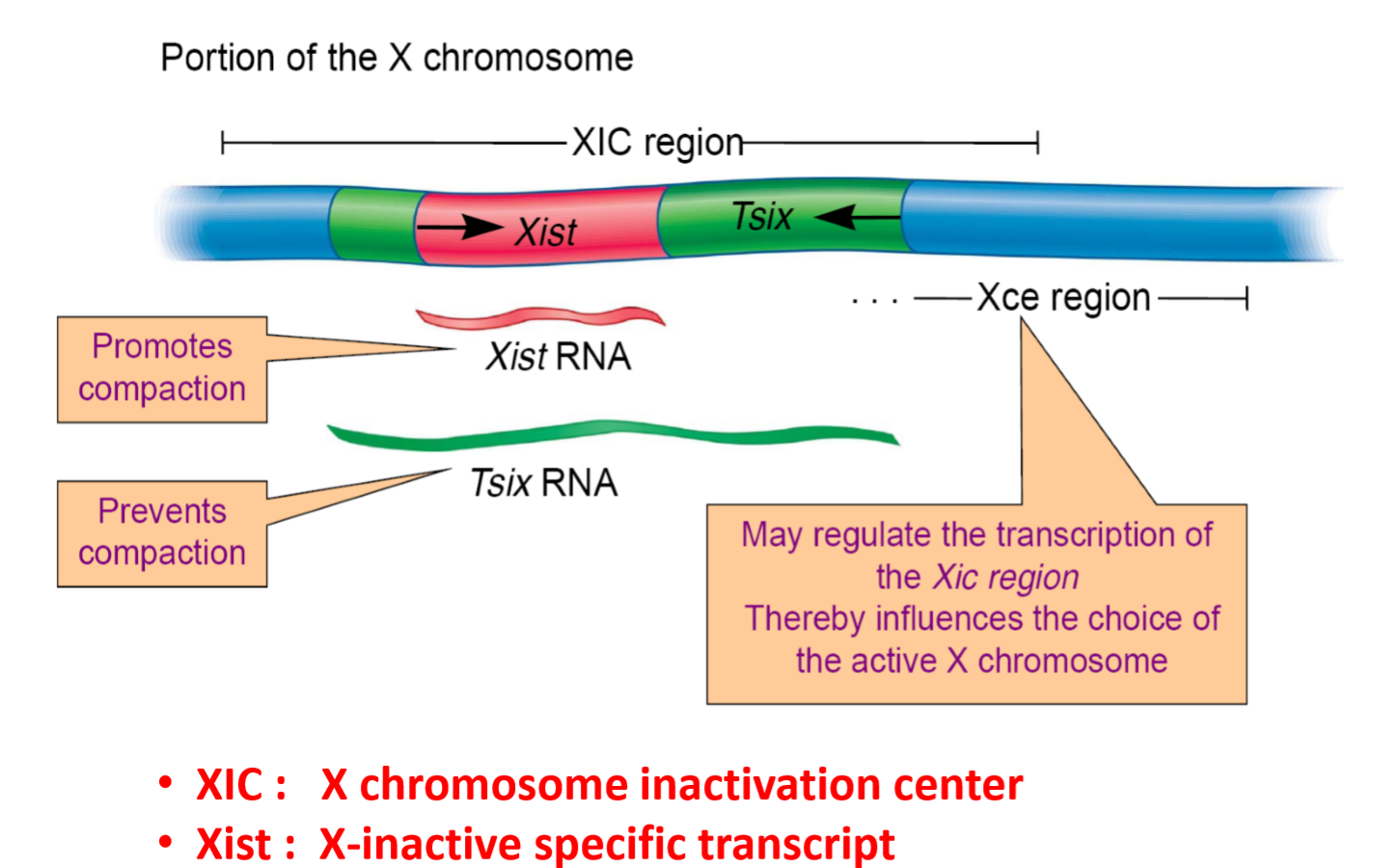
在X染色体去活化发生之前,两个X染色体都会均会表现Xist和Tsix,当去活化开始时,Xi将停止表现Tsix,使Xist的表现量增加;Xa则保持Tsix的表现,使Xist的表现量维持在较低水平
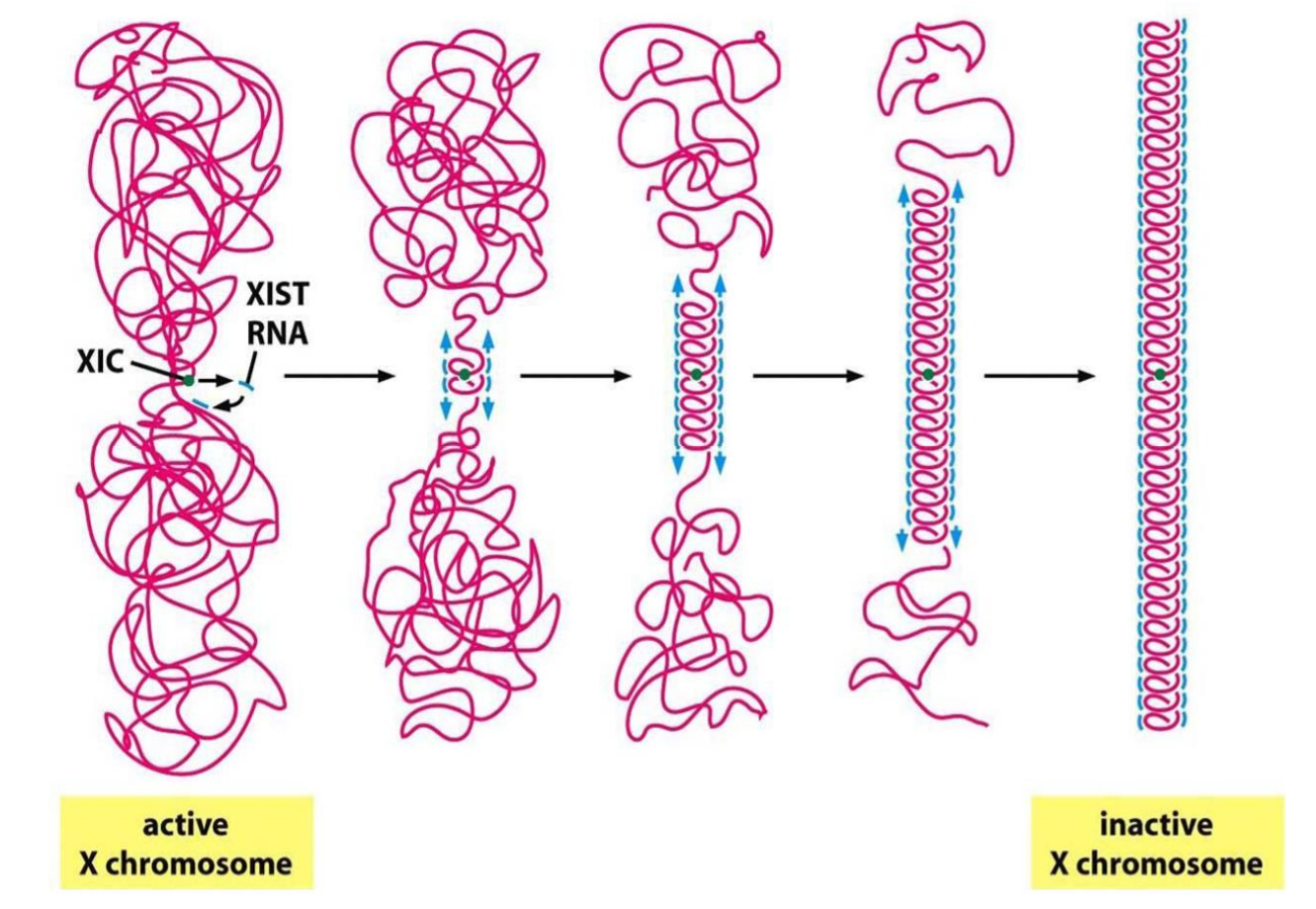
Formation of Barr Body
- Initiation: Occurs during embryonic development. One of the X chromosome remains active and the other is targeted for inactivation.
- Spreading: Occurs during embryonic development. It begins at the XIC (X chromosomal controlling element) and progresses toward both ends until the entire chromosome is inactivated. The Xist gene (present within the XIC) encodes an RNA that coats the X chromosome and recruits proteins that promote its compaction into a Barr body.
- Maintenance: Occurs from embryonic development through adult life. The inactivated X chromosome is maintained as such during subsequent cell divisions.
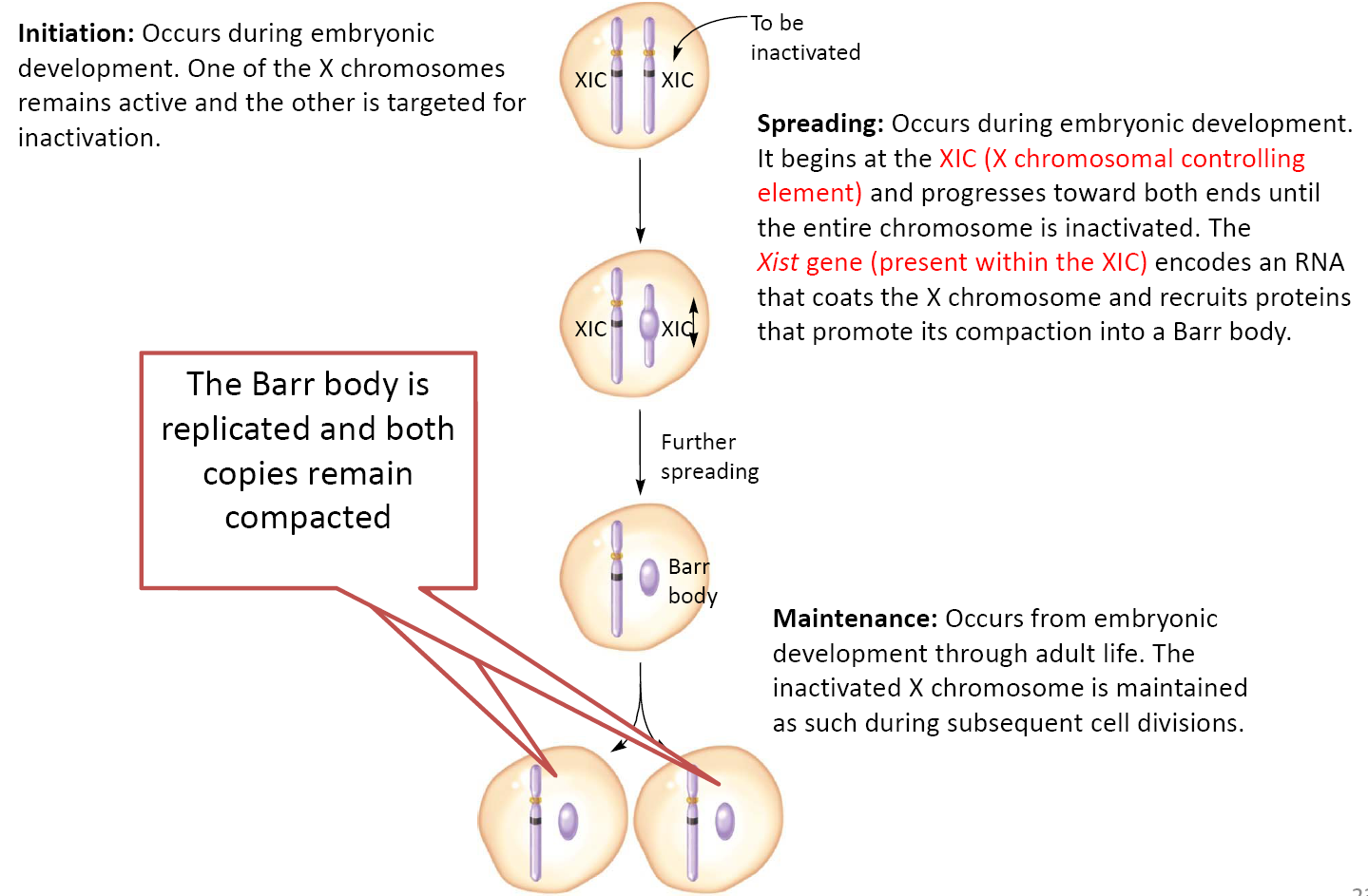
3. Genomic/genetic imprinting 基因印记
Introduction
Genomic imprinting (基因印记或遗传印记)is a phenomenon in which expression of a gene depends on whether it is inherited from the male or the female parent
Forms of genomic imprinting have been demonstrated in fungi, plants and animals( mammals, insects and flowering plants).
Imprinted genes follow a non‐Mendelian pattern of inheritance
Depending on how the genes are “marked”, the offspring expresses either the maternally‐inherited or the paternally-inherited allele
This is termed monoallelic expression (单等位基因表达)
基因印记是母本与父本基因”竞争“的过程,因为一些性状对于母本有利,有些性状对于父本有利。母本与父本通过基因印记选择某些基因的表达与否。
Thus genomic imprinting is permanent in the somatic cells of an animal
- However, the marking of alleles can be altered from generation to generation
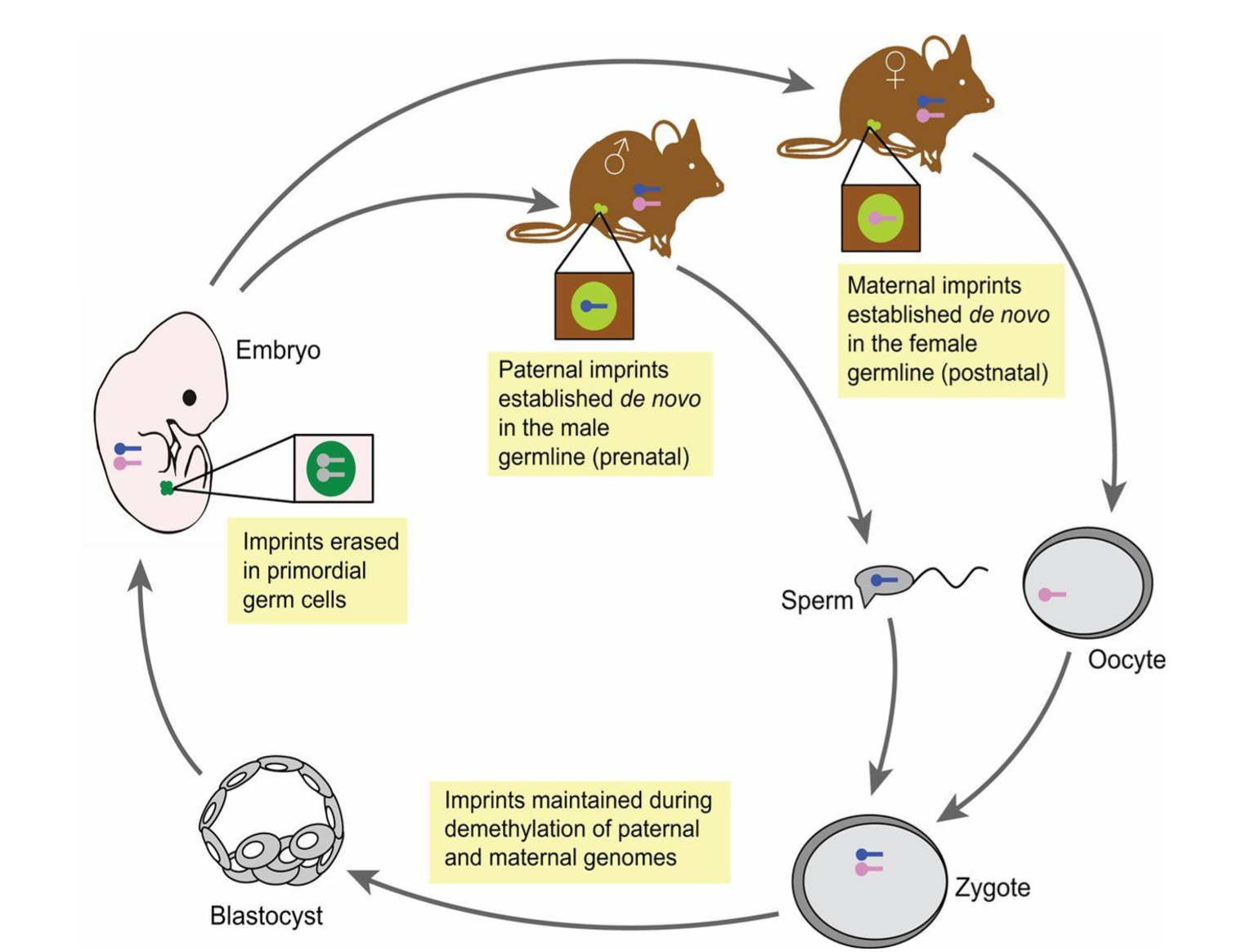
Genomic imprinting occurs in several species including mammals, insects and flowering plants
It may involve:
- A single gene
- A part of a chromosome
- An entire chromosome
- Even all the chromosomes from one parent
Examples
(1)lgf2 gene
The Igf2 gene encodes a growth hormone called insulin‐like growth factor 2
- A functional Igf2 gene is necessary for a normal size
Imprinting results in the expression of the paternal but not the maternal allele
The paternal (父亲的) allele is transcribed into RNA
The maternal (母亲的) allele is not transcribed
$Igf2^{-}$ is a loss‐of‐function allele that does not express a functional Igf2 protein
- This may cause a mouse to be dwarf depending on whether it inherits the mutant allele from its father or from its mother
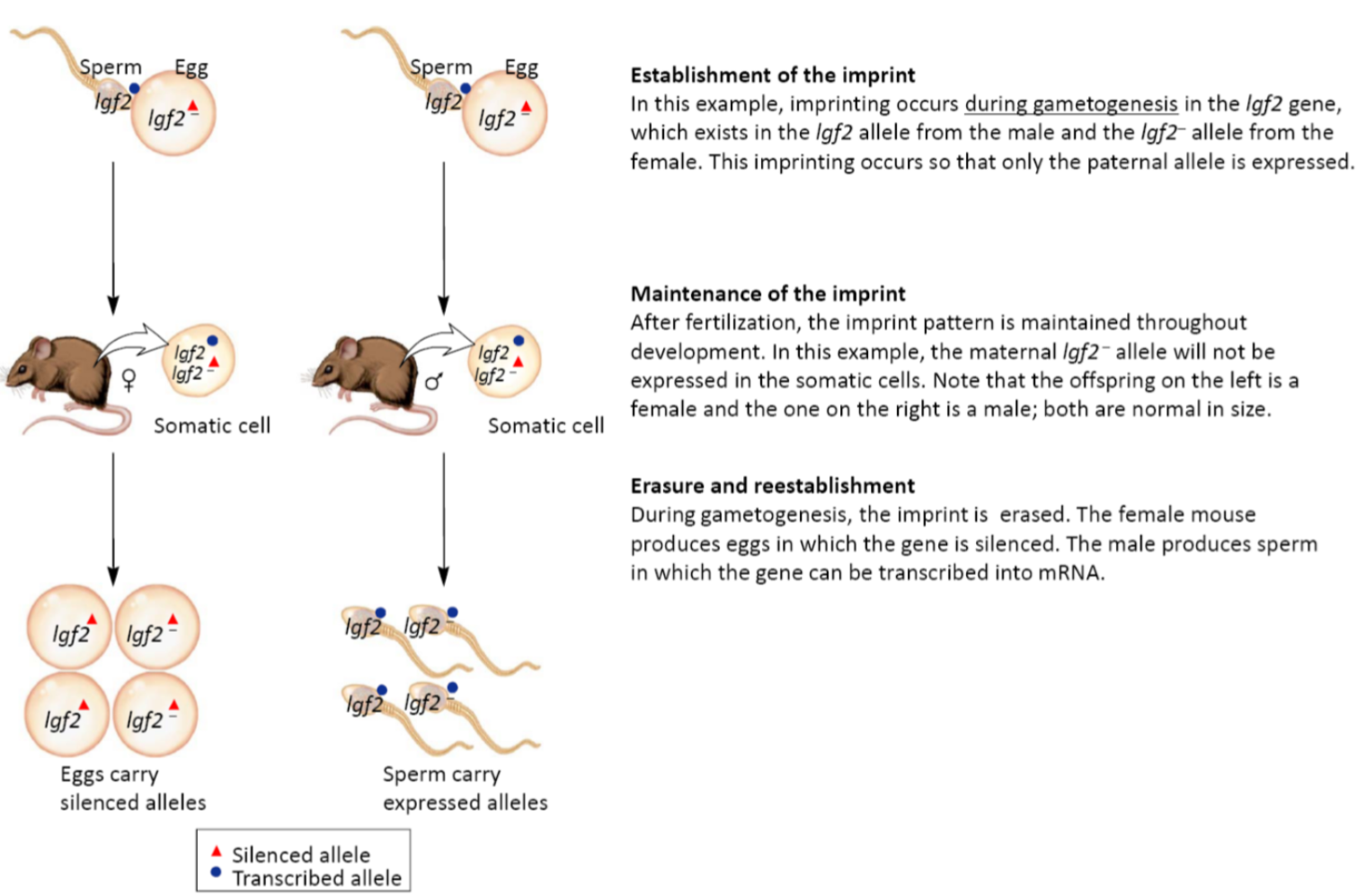
- Establishment of the imprint: In this example, imprinting occurs during gametogenesis in the Igf2 gene, which exists in the Igf2 allele from the male and the $Igf2^{-}$ allele from the female. This imprinting occurs so that only the paternal allele is expressed.
- Maintenance of the imprint: After fertilization, the imprint pattern is maintained throughout development. In this example, the maternal $Igf2^{-}$ allele will not be expressed in the somatic cells. Note that the offspring on the left is a female and the one on the right is a male; both are normal in size.
- Erasure and reestablishment: During gametogenesis, the imprint is erased. The female mouse produces eggs in which the gene is silenced. The male produces sperm in which the gene can be transcribed into mRNA.
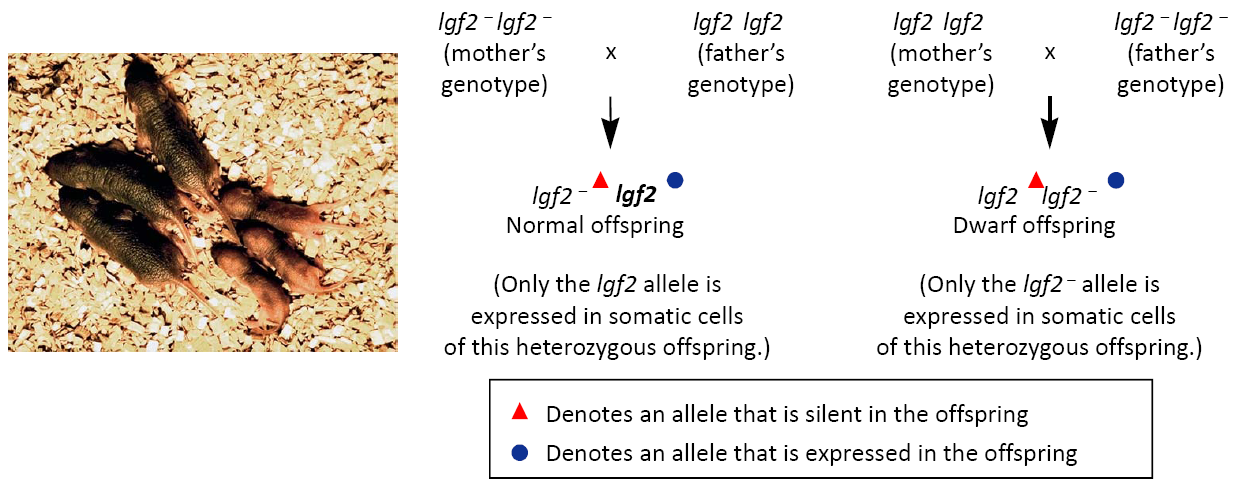
(2)Human diseases that involve imprinted genes
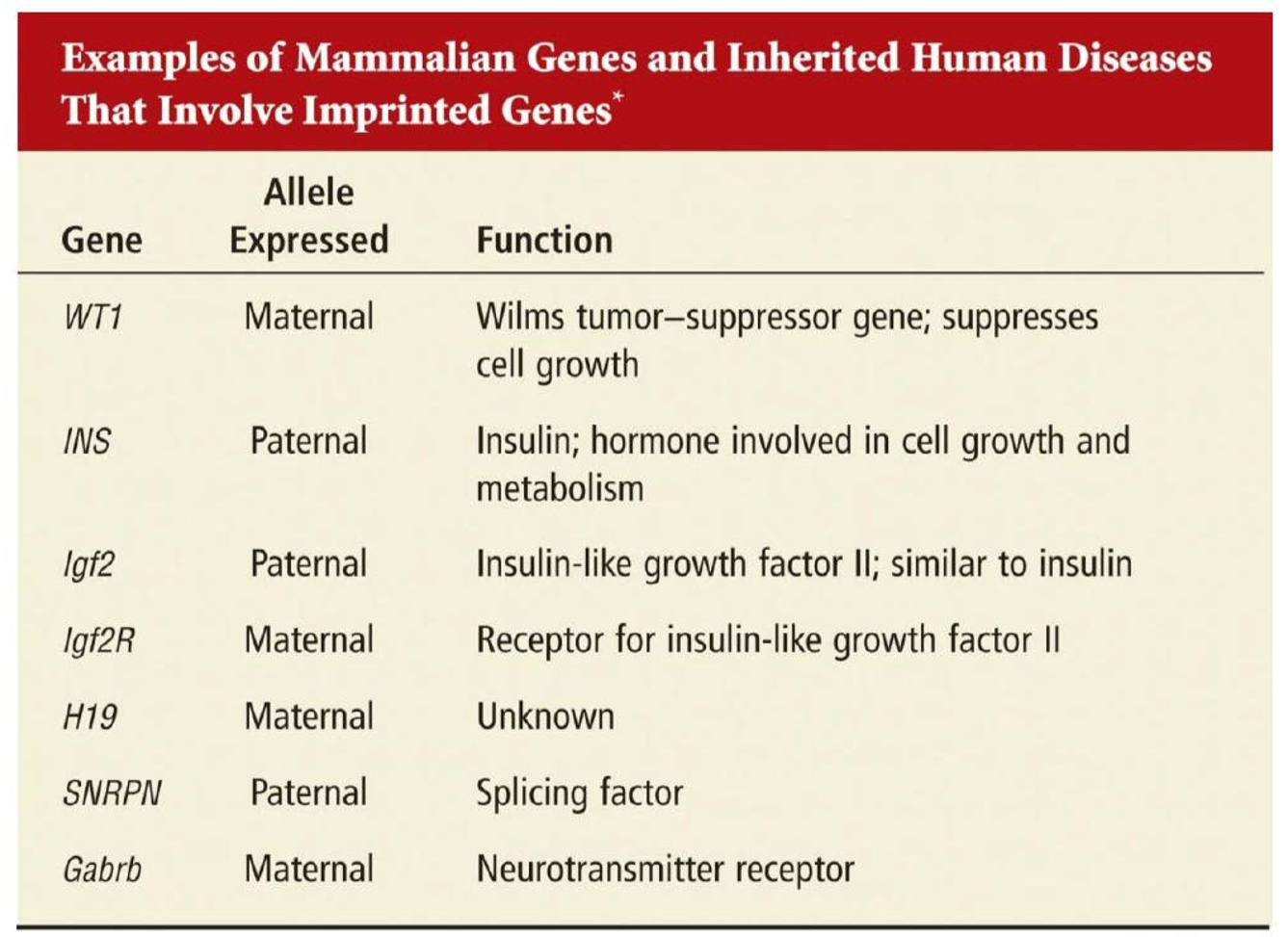
Besides Imprinting does play a role in the inheritance of certain human diseases such as Prader‐Willi syndrome (PWS) and Angelman syndrome (AS, 快乐木偶综合症, 又称天使综合征)
PWS is characterized by
Reduced motor function
Obesity
Mental deficiencies
AS is characterized by
- Hyperactivity
- Unusual seizures (癫痫,痉挛)
- Repetitive symmetrical muscle movements
- Mental deficiencies
Most commonly, PWS and AS involve a small deletion in chromosome 15
- If it is inherited from the mother, it leads to AS
- If it is inherited from the father, it leads to PWS
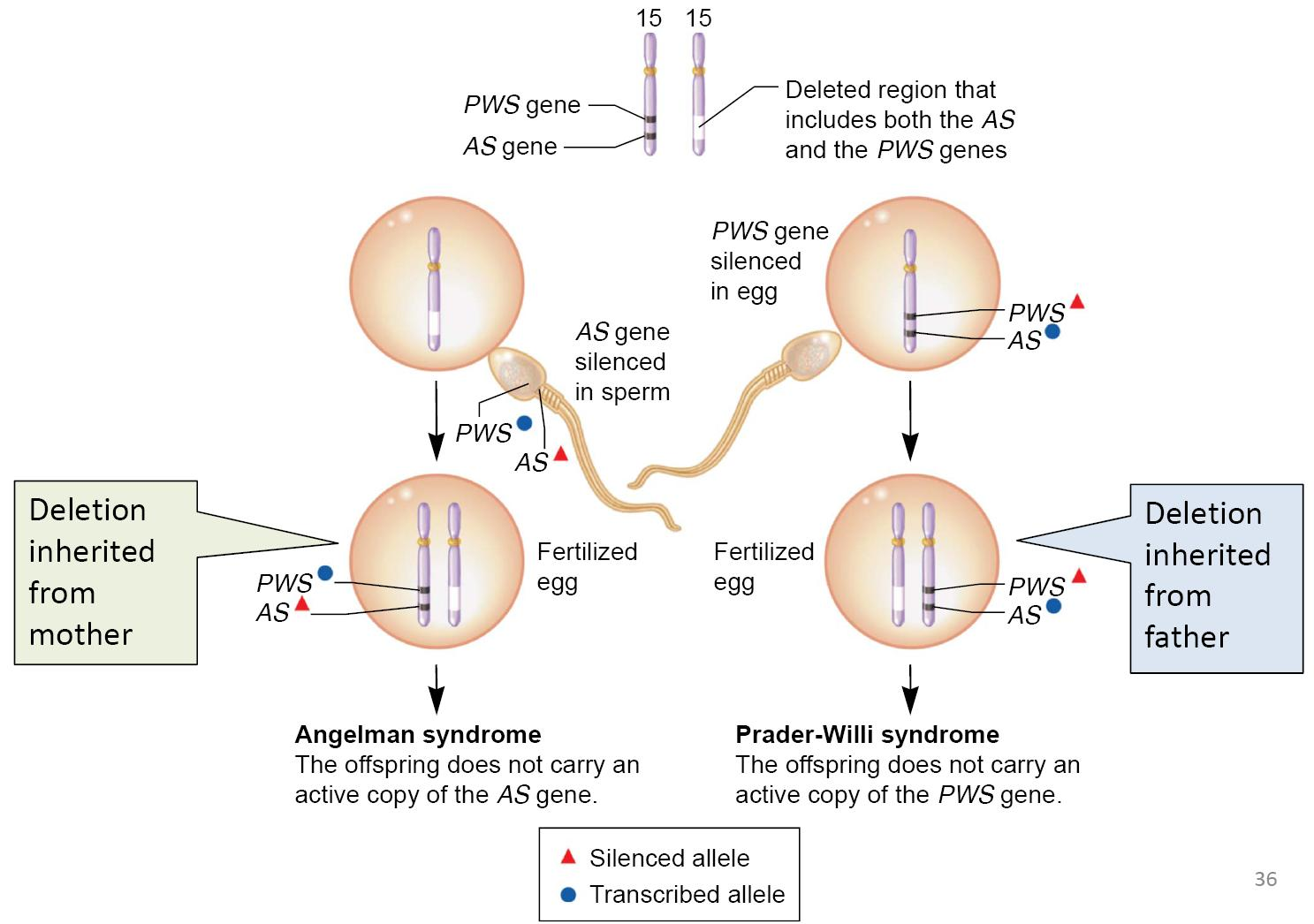
Imprinting and DNA Methylation
Genomic imprinting must involve a marking process
At the molecular level, the imprinting of several genes is known to involve an imprinting control region (ICR; 印记控制区) located near the imprinted gene.
The ICR contains binding sites for one or more transcription factors that regulate the imprinted gene
A portion of the DNA in this region is called the differentially methylated domain (DMD; 差异性甲基化区域)
The DMD is methylated either in the oocyte or sperm —— Not both
DNA Methylation Functions
(1) Silencing
For most genes, methylation at a DMD results in inhibition of gene expression
Methylation could:
- Enhance (提高,加强) the binding of proteins that inhibit transcription and/or Inhibit the binding of proteins that enhance transcription
Because of this, imprinting is usually described as a process that silences gene expression by preventing transcription
- However, this is not always the case
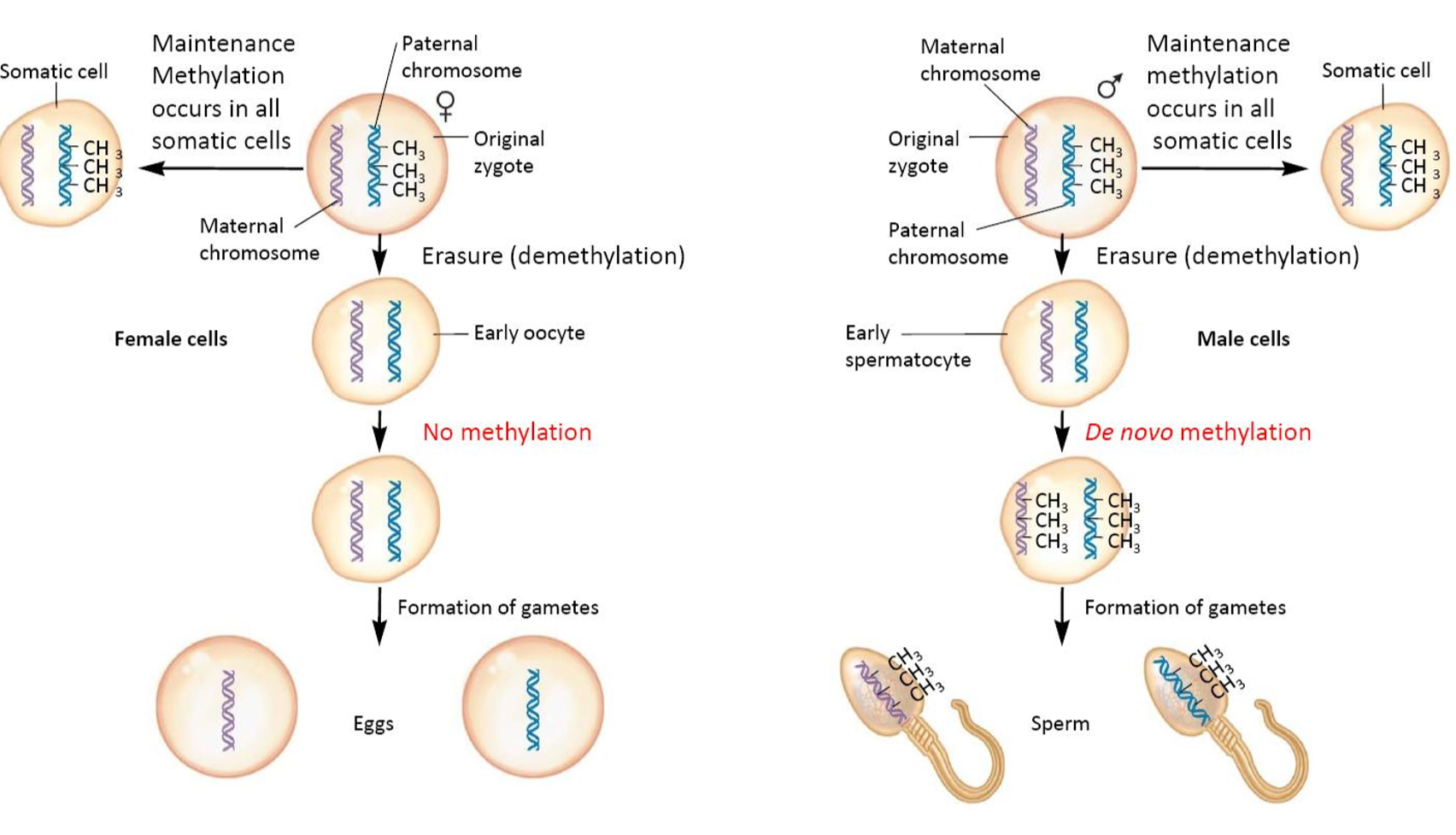
(2) Enhancement
Consider two imprinted genes in humans, H19 and Igf2
They lie close to each other on human chromosome 11
Appear to be controlled by the same ICR

This ICR
Is ~ 52,000 bp
Contains binding sites for proteins that regulate the transcription of both genes
Is highly methylated on the paternally inherited chromosome but not on the maternally inherited chromosome
Extranuclear inheritance 核外遗传
- Involves genes in organelles other than the nucleus
- Mitochondria
- Chloroplasts